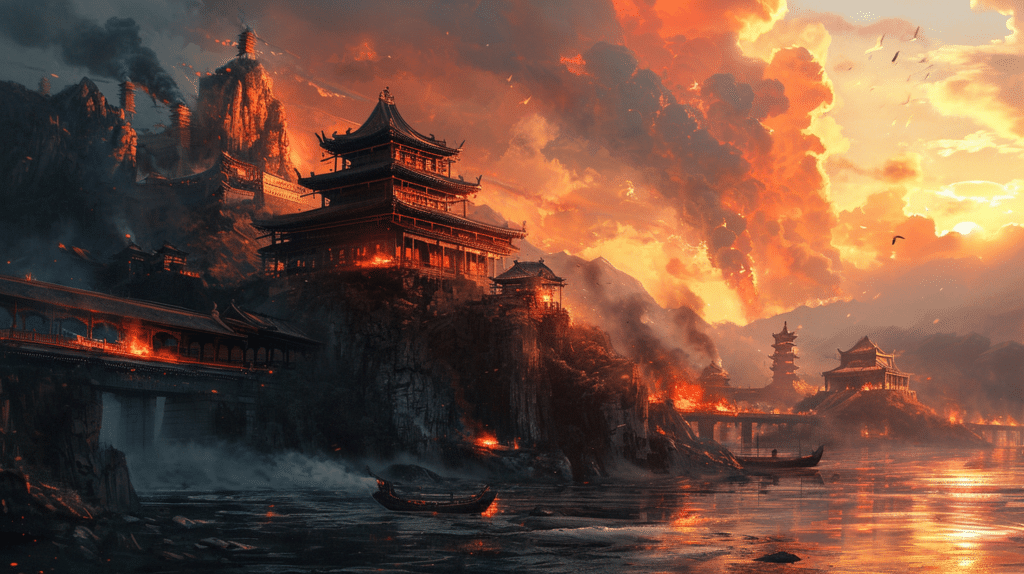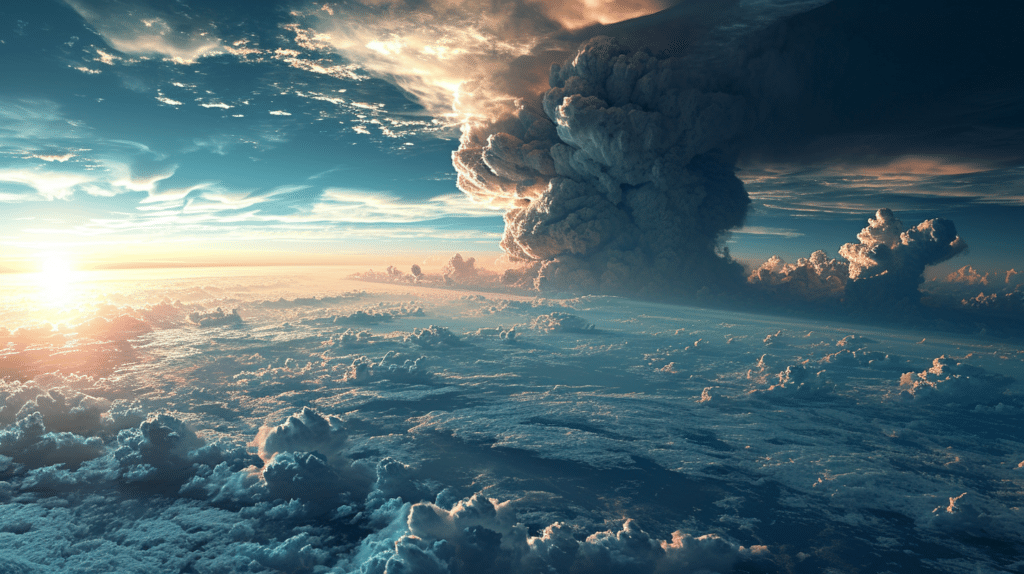As tensions between nations escalate, the world holds its breath in anticipation of the outbreak of World War 3. The geopolitical landscape is fraught with rivalries and power struggles, creating a volatile environment where a single spark could ignite a catastrophic conflict. The stakes are high, with global superpowers vying for dominance and smaller nations caught in the crossfire. The world watches anxiously as the tension rises, knowing that the consequences of this conflict could be devastating.

The Trigger Event: Sparking the Conflict
The trigger event that ignited the flames of World War 3 was the Islamic empires’ restriction on Christian pilgrimage to the Holy Land. This limitation stoked deep resentment and tension between the Christian and Islamic worlds, leading to the Crusades—an epic saga of attempts to reclaim access to sacred sites in Jerusalem. The Crusades marked the beginning of a long and bloody struggle that would shape the course of history.
The Major Players in World War 3
Superpowers Collide: USA vs China
The clash between the United States and China resembles a high-stakes poker game, with both superpowers ramping up their military and diplomatic efforts in Asia. The US, in what some are calling a ‘once in a generation effort’, is working diligently to cement military ties in the region to counter China’s growing influence. This escalating rivalry may reshape the geopolitical landscape in ways we can hardly fathom, and as tensions surge, the world watches with bated breath for the outcome of this titanic struggle.

The European Union’s Role in the Conflict
The European Union (EU) plays a crucial role in the cataclysmic conflict of World War 3. As a political and economic union comprising 27 member states, the EU wields significant influence on the global stage. In the face of escalating tensions, the EU has actively engaged in diplomatic efforts to de-escalate the situation and promote peace. Through its collective security and defense policies, the EU aims to ensure the stability and security of its member states and the wider region.
The EU has also been instrumental in providing humanitarian aid and support to affected regions. Mobilizing resources and coordinating relief efforts, it has worked tirelessly to assist impacted communities. Additionally, the EU has implemented economic sanctions and trade restrictions to exert pressure on aggressor nations and deter further escalation of the conflict.
As articulated in The Secret Teachings with Ryan Gable, ‘The European Union’s involvement in World War 3 highlights the importance of international cooperation and diplomacy in times of crisis.’ The EU’s actions underscore the complex dynamics and interconnectedness of global politics and the collaborative efforts needed to maintain peace and stability.
Russia’s Ambitions and Involvement
Russia plays a pivotal role in the unfolding saga of World War 3. With its vast territory and military capabilities, Russia harbors ambitions of reclaiming its status as a global superpower. One of Russia’s primary goals is to expand its influence and assert dominance in Eastern Europe and Central Asia while establishing a sphere of influence over neighboring countries. This includes backing proxy forces and engaging in cyber warfare to destabilize its adversaries, adding yet another layer of complexity to an already volatile global situation.
The Battlefield: Global Hotspots
The Middle East: A Powder Keg
The Middle East has long been a region marred by intense geopolitical tensions and conflicts. With its rich history, diverse cultures, and strategic location, it stands as a powder keg waiting to explode. Ongoing power struggles, religious rivalries, and territorial disputes create a precarious environment, ripe for igniting a global conflict. The entanglement of major world powers and their competing interests only complicates the situation, turning this region into a battleground for proxy wars. The Middle East is undoubtedly a ticking time bomb, with catastrophic potential.
Asia-Pacific: A Region on the Brink
The Asia-Pacific region is rife with geopolitical tensions and economic rivalries. Major powers like China, the United States, and Japan are vying for influence, raising the stakes significantly. Business leaders in the region are on the brink of a historic moment in the battle against inequality. Their responses could determine the trajectory of global stability. According to a tantalizing report by PwC, the Net Zero Economy Index Asia Pacific Cut 2023, this region holds the potential to lead the charge in transitioning to a sustainable and inclusive economy.
By embracing sustainable practices and investing in green technologies, the Asia-Pacific region can mitigate potential conflicts while paving the way for a brighter future.

Europe: Caught in the Crossfire
As World War 3 unfolds, Europe finds itself precariously positioned between warring global powers. With its strategic importance and historical legacy, the continent becomes a battleground for competing interests as nations like the United States, China, and Russia jockey for influence over European nations.
Support more articles like this.
Weapons of Mass Destruction: Unleashing Hell
Nuclear Armageddon: The Ultimate Threat
The threat posed by nuclear weapons looms ominously in the context of World War 3. International bodies and proliferation experts warn that the danger of nuclear weapons use has reached historic levels. The destructive potential of these weapons is staggering, capable of erasing entire cities and unleashing environmental devastation. The specter of accidental or intentional nuclear strikes haunts the global community, underscoring the urgency of preventing proliferation and promoting disarmament to stave off an apocalyptic scenario.

Biological Warfare: Silent and Deadly
Biological warfare, a sinister method relying on deadly pathogens and toxins, can cause mass destruction and indiscriminate death. These insidious weapons can remain undetectable, complicating defenses against them. The implications for both military and civilian populations are dire. The Biological Weapons Convention (BWC) is a critical treaty banning biological and toxin weapons, aiming to curb their use and ensure global security.
Peace with Biological Weapons
The BWC opened for signature in 1972 and has since received ratification from 183 countries. It prohibits the development, production, stockpiling, and acquisition of biological weapons, requiring nations to destroy existing stockpiles while aiding states affected by biological weapon attacks. While the BWC has made significant strides in reducing the threat of biological warfare, vigilance remains crucial.
The Threat Remains
Though the BWC has been vital in diminishing biological weapons usage, the risk lingers. Technological advancements in biotechnology and genetic engineering have made it easier for rogue states and terrorist organizations to pursue these deadly capabilities. The international community must bolster prevention measures, enhance surveillance, improve detection capabilities, and foster global cooperation to combat this persistent threat.
In conclusion, biological warfare poses significant risks to global security. The BWC stands as an essential framework ensuring the prohibition of these devastating weapons, yet ongoing commitment to address emerging threats is vital for safeguarding future generations.
Cyber Attacks: The New Battlefield
In our digital era, cyber attacks have emerged as a contemporary battlefield. As nations increasingly depend on technology, they become vulnerable to attacks aiming to disrupt critical infrastructure and undermine public trust. In 2023, India faced a surge in cyber threats resulting in compromised personal information and major operational disruptions. Looking ahead, experts anticipate that generative AI may soon revolutionize cyber warfare, rendering attacks more sophisticated and difficult to detect.
The Human Cost: Lives Lost and Nations Destroyed
Millions Dead: The Toll of World War 3
World War 3 has wrought a devastating legacy of destruction, claiming millions of lives. The magnitude of the conflict exceeds that of any previous war in history, leaving entire cities in ruins and once-thriving communities decimated. The human toll is heart-wrenching, shaping a legacy of suffering that will echo through generations.
The consequences extend beyond mere loss of life—the economic impact is catastrophic. With global markets in chaos, nations teeter on the brink of collapse. Shattered infrastructure hinders rebuilding efforts, while the refugee crisis swells, forcing countless individuals from their homes into overcrowded camps. Societies struggle to mend the frayed social fabric left in war’s wake.
In light of such profound devastation, the international community must unite in aiding those affected by World War 3. Humanitarian support is essential in alleviating suffering and facilitating recovery. Diplomatic initiatives must ramp up to promote peaceful resolutions and avert future conflict. Only through collective action can humanity work toward a world where the horrors of World War 3 remain a distant memory.

Refugee Crisis: Displaced and Desperate
The refugee crisis stemming from World War 3 has engendered unprecedented dislocation and desperation. Millions flee their homes, seeking security and solace in neighboring regions or across continents. The magnitude of this crisis is staggering, with Syria alone accounting for nearly 25% of the global refugee population.
By mid-2023, approximately 6.49 million Syrians have been displaced, presenting immense humanitarian challenges that extend beyond immediate needs. The influx imposes heavy burdens on host countries, leading to social, economic, and political difficulties.
Economic Collapse: The Aftermath of Destruction
The economic devastation accompanying World War 3 is colossal, with nations left in ruins and economies shattered. The obliteration of infrastructure, loss of resources, and brain drain leave countries struggling to rise from ash heaps. Hyperinflation wreaks havoc as currencies become increasingly worthless. The global financial system faces chaos, banks crumble, and markets collapse—creating an undeniably bleak atmosphere for survivors.
The aftermath brings new challenges as unemployment soars, industries collapse, and social unrest bubbles to the surface. Governments grapple with providing basic services as basic necessities dwindle. Food scarcity hangs heavy, as agricultural disruption wreaks havoc on supply chains, forcing individuals to scavenge for survival.
Moreover, geopolitical landscapes undergo seismic shifts. As once-powerful nations languish, emerging powers ascend to prominence, forging new alliances while others disintegrate amidst desperation. The global order teeters on a knife’s edge as factions jostle to regain stability.
The path to recovery promises to be long and arduous. Nations must not only reconstruct physical infrastructure but also heal the wounds of their societies. International cooperation and assistance play vital roles in navigating this labyrinth of challenges. An investment in rebuilding education, healthcare, and infrastructure lays groundwork for nurturing resilient futures.
The Endgame: Seeking Peace in the Chaos
Diplomatic Efforts: Can Talks Prevent Disaster?
Amid chaos, diplomatic efforts emerge as glimmers of hope. With nations reeling from devastation, world leaders converge in high-stakes negotiations with a common goal: achieve a peaceful resolution and avert further catastrophe.
Yet, these negotiations are fraught with challenges. Deep-rooted grudges, jarring interests, and power plays threaten to derail progress. But the alternative? Unthinkable. The world cannot afford to allow the flames of conflict to engulf nations and lives.
To facilitate these discussions, international organizations take center stage. They provide neutral platforms for dialogue and negotiation, bringing representatives together from diverse backgrounds. Through diplomatic channels, they strive to bridge divides and foster agreement.
However, can mere talks keep disaster at bay? The answer remains complex. While diplomacy offers potential paths to peace, it demands commitment and compromise. Leaders must prioritize the welfare of their constituents over personal ambitions, recognizing our shared humanity. It requires acknowledging that conflict is not the solution.
With monumental challenges on the horizon, the world watches these diplomatic endeavors with a mixture of hope and skepticism. High stakes loom, and failure promises dire outcomes. Conversely, success opens the potential not just to save lives but to reshape nations and to construct a future devoid of the specter of World War 3.

The Role of International Organizations
Entities such as the United Nations serve as vital players in navigating the stormy seas of World War 3, fostering peace and stability. Their facilitation of discussions enables clarity amid the chaos. The cooperation of international bodies remains paramount in addressing the fallout and working toward lasting solutions.
Rebuilding Nations: From Ashes to Hope
After the devastation of World War 3, the daunting responsibility of rebuilding nations rests with governments, aid organizations, and resilient communities. Despite the lengthy and challenging path to recovery, hope persists. Varied organizations have mobilized resources to support devastated communities, targeting not only immediate needs but also laying groundwork for sustainable future growth. Conversations around the rebuilding efforts abound, with some residents attributing the crisis to divine retribution while others grapple with governance issues. Regardless, the human spirit remains resolute, eager to rise from the ruins.
In the depths of uncertainty, peace may appear elusive. But organizations dedicated to unearthing truths behind parapolitics and conspiracies are committed to shining light on the complexities that shape our world. For insights and discussions on these enigmatic issues, visit Unexplained.co to learn more.
In Conclusion
This examination of World War 3 has navigated the potential triggers, consequences, and ramifications of what could become a global catastrophe. From the catastrophic ramifications for human lives to crippling economic disruptions, the narrative sheds light on the dire nature of conflict. To avert such a future, it remains essential for nations to prioritize diplomacy, constructive partnerships, and international cooperation. History has taught profound lessons, and we must forge a future defined by peace.
Frequently Asked Questions
What were the main causes of World War 3?
The main causes included rising tensions among superpowers, significant trigger events, and the ambitions of major players like the USA, China, and Russia.
Which regions were the major battlegrounds in World War 3?
The battlegrounds primarily included the Middle East, Asia-Pacific, and Europe.
What were the weapons of mass destruction used in World War 3?
The conflict involved nuclear weapons, biological warfare, and cyber attacks as key instruments of destruction.
How many lives were lost in World War 3?
The toll in lives lost reached millions, marking an unprecedented humanitarian catastrophe.
What were the consequences of World War 3?
The aftermath included a significant refugee crisis, economic collapse, and widespread devastation of nations.
Were there any efforts to seek peace during World War 3?
Indeed, numerous diplomatic initiatives were launched, bolstered by the commitment of various international organizations to foster peace and facilitate post-war recovery efforts.




